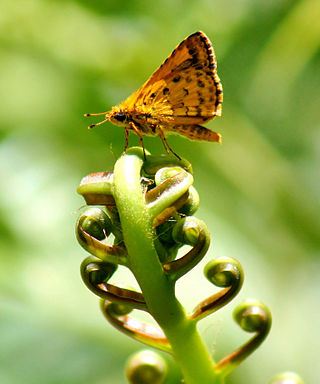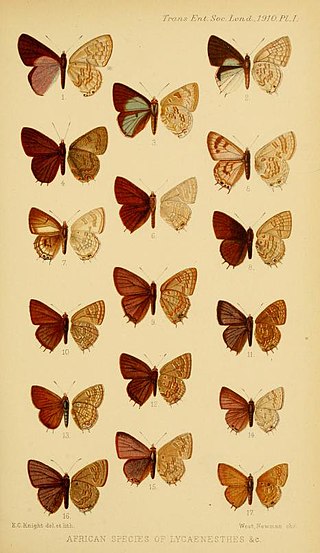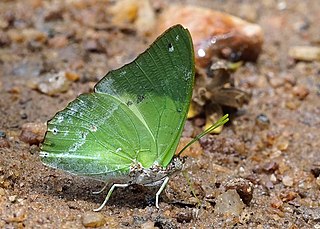
Celaenorrhinus is a genus of skipper butterflies which are commonly termed sprites. An alternate name is flats, for their habit of holding their wings flat when resting, but this is also used for related genera. They are the type genus of tribe Celaenorrhinini.

Ampittia is the genus of bush hoppers in the skipper butterfly family, Hesperiidae. It is the only member of the tribe Ampittiini.

Cupidesthes is a genus of butterflies in the family Lycaenidae. The species of this genus are found in the Afrotropical realm. The genus Cupidesthes was erected by Per Olof Christopher Aurivillius in 1895.

Capys is a genus of butterflies in the family Lycaenidae. The species of this genus are found in the Afrotropical realm.

Charaxes brutus, the white-barred emperor or white-barred Charaxes, is a butterfly of the family Nymphalidae. It is found in Africa.

Andronymus is an Afrotropical genus of grass skippers in the family Hesperiidae.

Gretna is a genus of skipper butterflies in the family Hesperiidae. It is the only genus in the monotypic tribe Gretnini.

Mimene is an Australasian genus of grass skippers in the family Hesperiidae.

Platylesches is a genus of skipper butterflies in the family Hesperiidae, commonly called hoppers, found in Africa.

Charaxes castor, the giant emperor or giant charaxes, is a butterfly of the family Nymphalidae. It is found throughout the Afrotropical realm below the Sahel.

Charaxes acuminatus, the pointed pearl charaxes or mountain pearl charaxes, is a butterfly in the family Nymphalidae. It is found in Uganda, Rwanda, Burundi, Kenya, Tanzania, the Democratic Republic of the Congo, Malawi, Zambia and Zimbabwe.

Charaxes eupale, the common green charaxes, is a butterfly in the family Nymphalidae. It is found in Senegal, Guinea, Sierra Leone, Liberia, Ivory Coast, Ghana, Togo, Nigeria, Cameroon, Gabon, the Republic of the Congo, the Central African Republic, Angola, Zambia, the Democratic Republic of the Congo, Uganda, Sudan, Rwanda, Kenya, Tanzania and Malawi.
Cephetola is a genus of butterflies in the family Lycaenidae. All species are endemic to the Afrotropical realm.

The Erionotini are a tribe of skipper butterflies in the subfamily Hesperiinae.

Gorgyra is an Afrotropical genus of grass skippers in the family Hesperiidae. Larvae feed mainly on Connaraceae, including Rourea. Other recorded larval food plants include Drypetes and Macadamia. Their habitat is generally lowland tropical rain forest and savanna.
Andronymus fontainei is a butterfly in the family Hesperiidae. It is found in the Democratic Republic of the Congo and is possibly endemic to the Albertine Rift.
Chondrolepis ducarmei is a species of butterfly in the family Hesperiidae. It is found in the Democratic Republic of the Congo and is endemic to the Albertine Rift. The habitat consists of submontane areas.
Chondrolepis uluguru is a species of butterfly in the family Hesperiidae. It is found in the Uluguru Mountains of Tanzania. The habitat consists of submontane areas.

Matapa is a genus of grass skipper butterflies in the family Hesperiidae. The species of this genus occur in the Indomalayan realm, from India to Sulawesi. They are mainly crepuscular and have red eyes.












